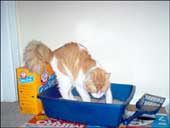
For most cat owners, one of the biggest drawbacks of owning a cat is the dreaded cat litter box.
Not many people like to clean litter boxes. They aren't just smelly. Litter can be quite dusty and people that change litter boxes are more vulnerable to some cat diseases that can be caught by humans than people that do not change their cats' litter boxes.
Luckily, there are several news littesr boxes designs that make the task of change cat litter much easier. One popular design is the hooded litter box.
These boxes provide privacy for more sensitive cats, but they also help keep down litter dust. The hooded box is ideal for a single cat, as long as the cat's owners can change the box frequently to keep it smelling clean and fresh. For people who don't want to handle the soiled litter, there are removable liners for these boxes. Simply lift out the whole liner filled with soiled litter and discard it. Lay down a new liner, add fresh cat litter, and replace the lid.
It is fairly easy to teach your kitten to use a litter box. The most important things for you to do are to position the litter box in the right place and to keep it extremely clean. Litter boxes should never be placed next to your cat's sleeping or eating spots, as cats do their best to keep these areas clean.
If your cat does not use the litter box, do not scold him for his accidents. He will just become angry and frustrated. Instead, place the box in the spot where he most frequently has accidents and encourage him to use it.
More information about cats and kittens free cats ebook


